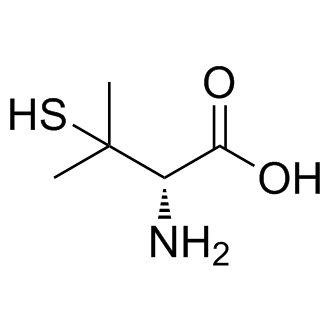
Penicillamine (Cuprimine, Depen) is used as an antirheumatic and as a chelating agent in Wilson’s disease and is a chelating agent recommended for the removal of excess copper in patients with Wilson’s disease. From in vitro studies which indicate that one atom of copper combines with two molecules of penicillamine. Penicillamine also reduces excess cystine excretion in cystinuria. The mechanism of action of penicillamine in rheumatoid arthritis is unknown although it appears to suppress disease activity. Unlike cytotoxic immunosuppressants, penicillamine markedly lowers IgM rheumatoid factor but produces no significant depression in absolute levels of serum immunoglobulins. Also unlike cytotoxic immunosuppressants which act on both, penicillamine in vitro depresses T-cell activity but not B-cell activity.
| Molecular Weight | 149.21 |
| Formula | C5H11NO2S |
| CAS Number | 52-67-5 |
| Solubility (25°C) | Water 30 mg/mL |
| Storage |
Powder -20°C 3 years ; 4°C 2 years In solvent -80°C 6 months ; -20°C 1 month |
| Species | Mouse | Rat | Rabbit | Guinea pig | Hamster | Dog |
| Weight (kg) | 0.02 | 0.15 | 1.8 | 0.4 | 0.08 | 10 |
| Body Surface Area (m2) | 0.007 | 0.025 | 0.15 | 0.05 | 0.02 | 0.5 |
| Km factor | 3 | 6 | 12 | 8 | 5 | 20 |
| Animal A (mg/kg) = Animal B (mg/kg) multiplied by | Animal B Km |
| Animal A Km |
For example, to modify the dose of Compound A used for a mouse (20 mg/kg) to a dose based on the BSA for a rat, multiply 20 mg/kg by the Km factor for a mouse and then divide by the Km factor for a rat. This calculation results in a rat equivalent dose for Compound A of 10 mg/kg.
[1] R Munro, et al. Penicillamine
[2] A Bialy-Golan, et al. Penicillamine-induced bullous dermatoses
| Related Products |
|---|
| Poly(ethylene glycol) diacrylate
Poly(ethylene glycol) diacrylate (PEGDA) is a blank slate hydrogel that gels rapidly at room temperature in the presence of a photoinitiator and light. PEGDA hydrogels are potent tools for uncovering basic cellular biology. PEGDA is an emerging scaffold for tissue engineering and regenerative medicine since polymerization can occur rapidly at room temperature, requires low energy input, has high water content, is elastic, and can be customized to include a variety of biological molecules. |
| Isothiuronium
Isothiouronium is a functional group, it is the acid salt of isothiourea. |
| Sultosilic acid, piperazine salt
Sultosilic acid piperazine salt is a compound with lowering lipid activity. It causes significant shortening of the euglobulin lysis time and a significant diminution of platelet adhesiveness, as well as statistically significant decrease of triglycerides, total cholesterol, beta- and pre-beta-cholesterol and an increase of alpha-cholesterol. |
| Ipamorelin
Ipamorelin (NNC-26-0161) is a a novel and potent ghrelin mimetic peptide compound that counteracts glucocorticoid-induced decrease in bone formation of adult rats. |
| PRGL493
PRGL493 is a potent and selective long-chain acyl-CoA synthetase 4 (ACSL4) inhibitor. PRGL493 blocks cell proliferation and tumor growth in both breast and prostate cellular and animal models. |


Products are for research use only. Not for human use. We do not sell to patients.
© Copyright 2010-2023 AbMole BioScience. All Rights Reserved.
